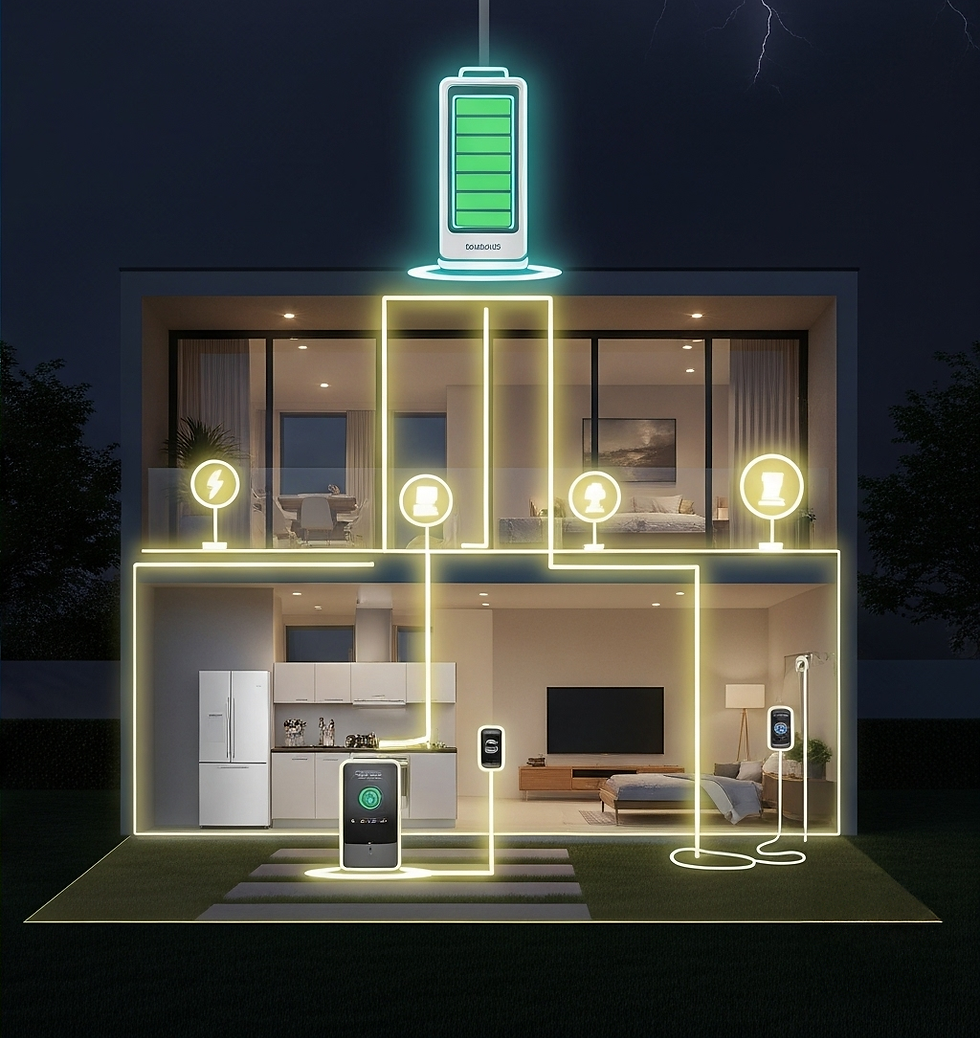Solar Battery Basics (Plain English, No Jargon)
- HH L
- Sep 9
- 3 min read
Updated: Sep 14
Installers and spec sheets are full of technical terms. Learn the basics in minutes so you can compare quotes fairly and avoid paying for things you don’t need.

1) Battery parts (what it’s made of) | Solar Battery Basics
In plain English: A battery is like Lego blocks—cells build modules, modules stack into a pack, and electronics keep it safe.
Cell — The smallest unit, like an AA battery on steroids.
Formats: Prismatic (brick), Cylindrical (tube), Pouch (foil-bag).
Module — A group of cells in a frame, easier to assemble or replace.
Stacking — Adding modules vertically, like adding floors. Many systems stack 5–20+ kWh.
Pack — The complete battery (modules + electronics + case).
BMS (Battery Management System) — The brain: balances cells, prevents over-charge/discharge, monitors safety.
Inverter/Charger — Turns DC into AC for your home, manages charging and discharging.
2) Key numbers to compare | Solar Battery Basics
In plain English: These are the specs that actually affect how the battery works at home.
kWh vs kW — kWh = tank size (energy stored). kW = tap flow (how much you can use at once).
Usable capacity — Not all the tank is usable. Always compare usable kWh, not nominal.
DoD / SoC — DoD = how much you used. SoC = how full it is now.
Round-trip efficiency — Energy out ÷ energy in. 90% means you lose ~10% in the cycle.
C-rate — How fast it charges/discharges relative to size. 1C = full charge/discharge in 1 hour.
Continuous vs Peak power — Continuous = what runs non-stop. Peak = short bursts (e.g., fridge compressor starting).
Cycle life & warranty capacity — How many times it can fully charge/discharge, and what % capacity remains at warranty end. Higher = better.
3) Battery types & safety | Solar Battery Basics
In plain English: Different chemistries balance cost, safety, and lifespan.
LFP (Lithium Iron Phosphate) — Safer, longer life, stable. Slightly heavier but ideal for homes.
NMC (Nickel Manganese Cobalt) — Packs more energy per kg, but needs stricter temperature management.
Thermal runaway — A chain reaction if overheated. Modern packs include BMS, fuses, and barriers to isolate and prevent issues.
4) What inspectors care about (safety & installation) | Solar Battery Basics
In plain English: These rules make sure your system is safe and approved.
IP rating (e.g., IP65) — Protection against dust and water. IP65 = dust-tight, resistant to water jets.
Clearances & mounting — Space for cooling and maintenance. Wall or floor mount per manufacturer.
Bollard — A post to stop cars bumping garage batteries.
Isolation & shut-down — Switches to safely disconnect in emergencies.
Ventilation & ambient limits — Avoid direct sun, standing water, or sealed spaces.
5) How it connects to your home (system integration)
In plain English: The wiring setup affects efficiency and compatibility.
AC-coupled — Battery has its own inverter. Flexible for retrofits.
DC-coupled — Battery connects on the PV DC side. Fewer conversions, higher efficiency in new installs.
MPPT (Maximum Power Point Tracking) — Squeezes maximum power from panels as sun/temperature change.
Essential vs whole-home backup — Essentials (fridge, lights, Wi-Fi, garage door) = cheaper, lasts longer. Whole-home = powers everything but needs bigger battery.
Transfer time — How fast it switches during blackout (milliseconds to seconds).
6) Extra features (smart & grid)
In plain English: Modern batteries are more than storage—they’re connected.
VPP-ready (Virtual Power Plant) — Join a network that supports the grid. You may earn bill credits but give the VPP some control.
Time-of-Use (TOU) — Charge off-peak, discharge at peak.
App & firmware — Monitor usage, SoC, and updates via phone or web.
7) How to read a spec sheet (example)
Spec:“13 kWh usable, 5 kW continuous / 7 kW 10-sec peak, 90% efficiency, 6,000 cycles, IP65”
Decoded:
✔13 kWh you can actually use
✔ Runs 5 kW continuously, handles 7 kW peaks briefly
✔Loses ~10% per full cycle (90% efficient)
✔ Rated for ~6,000 cycles (~10–15 years typical use)
✔ IP65: dust-tight, rain-resistant, OK outdoors with proper placement
✦ Key takeaway | Solar Battery Basics
When comparing quotes | Solar Battery Basics:
Always check usable kWh + output (kW), not just total size.
Look for LFP chemistry for safety and long life.
Ensure IP rating, ventilation, and installation standards are met.



Comments